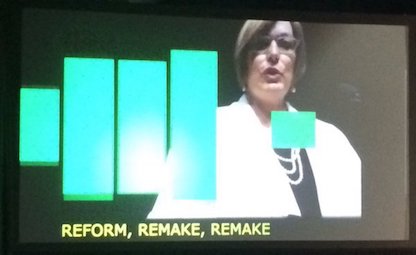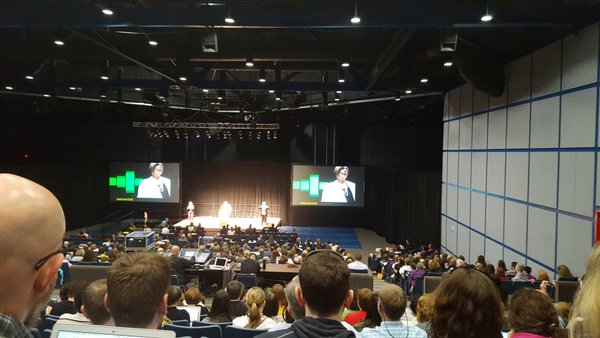
A History of Remediating the CCCC Chair's Address
We begin this webtext by providing some context for Joyce's address and our remediated video: First, we place her address in the context of a mediational history of CCCC Chairs' Addresses.

Joyce's talk also involved some technological innovations of her own. Whereas recent Chairs' Addresses have involved projecting digital slides on a screen that accompany the address, Joyce used the audio visualization software Magic to disrupt a live webcam feed of herself on the screen. The video feed transitioned between visualizations that disrupted the appearance of her face: In one moment, the video of Joyce's face was overlaid with green bars moving in response to the audio in the auditorium; in the next, Joyce's face in the video was itself distorted and shifting in automated response to these sounds. Joyce's hope was that such visualizations would be disruptive of audience members’ experiences, enacting (to a degree) her own vision of disruption.
This webtext shares our inventional processes of remediating Joyce’s address as a video to be posted on YouTube. The Convention Center in Houston video recorded the address, but when Joyce received the video, it had a few major limitations: First, it only showed her at the podium, not recording any of the ad-hoc or static visualizations displayed during her address. Nor, for that matter, did the video include the American Sign Language interpreters to her left and right, which, for those in attendance, were an important aspect of the experience of the Address: As punk music played during the opening, one interpreter played an "air guitar" quite vigorously. Second, and crucially, the video file cut off the last few minutes of Joyce’s talk, leaving it as an incomplete archive of the address.
Because this video was incomplete, Joyce and Michael Faris decided that this was a wonderful opportunity to remediate her address for video. They re-shot her address in Texas Tech University's Department of English Media Lab, where they recreated the visuals from Houston and video- and audio-recorded Joyce re-delivering her talk in front of a black screen. We decided to make remediating the address for a video an assignment in Michael's graduate course on New Media Rhetoric in May 2016. Sarah Austin and Erica Stone volunteered to work on the project during the intensive two-week course. Their assignment was to create a video version of the address, drawing on the raw materials Michael and Joyce provided, that stayed true to the verbal argument of her address but also gave new viewers a sense of how Joyce disrupted the traditional use of visuals during her talk. We hoped this video would not simply recreate the talk in Houston, nor would it be a talking head video: We hoped to create something more dynamic, something that could keep viewers' attention and interest for the full 42 minutes of the address (a long time to watch a YouTube video!).
Below we provide the organizational structure to this webtext. Readers are welcome to read this webtext linearly, or they may choose to focus on Sarah and Erica's invention practices, discussed in the four nodes on remediation. We use the authorial "we" throughout this webtext, but in the four nodes on remediation, "we" refers to Sarah and Erica as they discuss their invention processes. Navigation is also provided on the left of each page—on smaller screens, readers will need to click the hamburger icon for the menu to appear (or disappear). Throughout this webtext, we share audio files recorded as Sarah and Erica worked on the video, screenshots, pictures, and excerpts from both the final video and drafts of the video.
In our conclusion, we discuss three implications of this project:
The final remediation can be watched on YouTube, on Joyce's blog, or on this webtext. We provide the final video for "Making, Disrupting, Innovating" in the main navigation menu on the left, as well as links to our author biographies and a few extras for readers. Two final notes: Throughout the text, we refer to Joyce by her first name along with the other authors here instead of the customary last name in citation practices. We also quote and reference Joyce's address frequently; we have opted to reference the timestamps in the video remediation rather than the text version Joyce posted to her blog after CCCC (Carter, 2016b) or the print version in College Composition and Communication (Carter, 2016a).